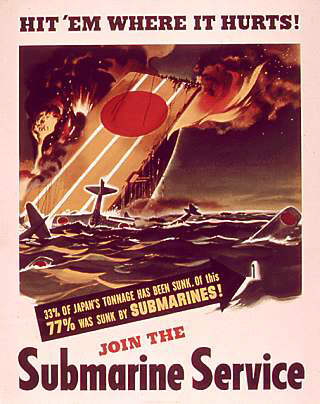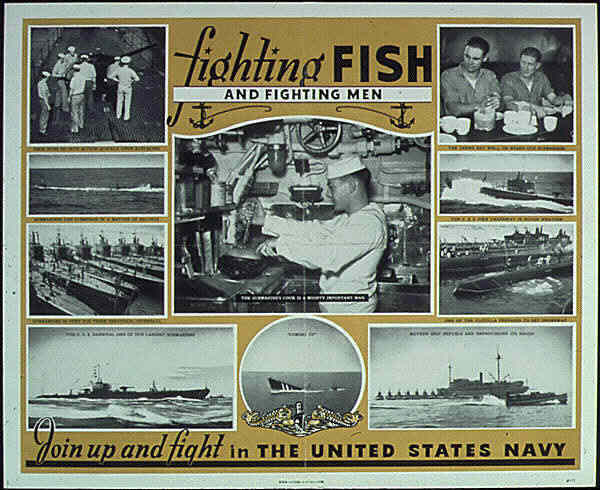















Posted on 06/11/2002 3:19:54 AM PDT by Snow Bunny

















Retired Navy Capt. Bill Dozier, 83, of Honolulu ,displays a photograph of himself, standing at far left, with fellow servicemen from 1942, at his home in Kailua, Hawaii, Friday, May 31, 2002. Dozier served on the USS Submarine Tambor during the Battle of Midway in World War II. Ceremonies to commemorate the 60th anniversary of the June 4-6 battle are planned across the nation this week. (AP Photo/Ronen Zilberman

"A fair wind, and a following sea," for Sam!

The late Clay Blair, Jr. Silent Victory: The US Submarine War Against Japan. A great read.
Thanks again.
Am glad you are.
Morning, Cob.
Morning, Doug
Oops! Maybe not this much wind. :)
None better, IMVHO!!

Japan started the war with some 6 million tons of merchant shipping capacity and built another 3 million tons during the course of the war. By war's end, only 1.8 million tons remained and 1.65 million tons of that was in "home" waters, unable to reach the sources of her needs. Of the 1.8 millions tons only 650,000 tons was serviceable. The missing 5,053,000 tons of merchant shipping in addition to the missing 214 warships (577,626 tons) and 69,600 Japanese merchant and naval seamen killed or incapcitated tells the story of the U.S. Naval Submarine Force during WWII.

What size force does it take to destroy over 50% on an enemy's merchant fleet; 29% of its warships and account for the loss of over 60% of its merchant and naval personnel? When it comes to submarines and submariners, not much. When the war started, the "Silent-Service" consisted of 111 "boats" in commission with 73 in various stages of building. 60 were stationed in the Atlantic under Commander Submarines Atlantic (ComSubLANT), headquartered in Groton, Connecticut. In the entire Pacific only 51 boats were available to carry the war to the enemy: 22 under Commander Submarines Pacific (ComSubPAC) at Pearl Harbor, Hawaii; and, 29 under Commander Submarines South West Pacific (ComSoWesPAC) at Manila in the Philippine Islands. 51 submarine crews took those 51 boats to sea to "conduct unrestricted warfare" upon the Japanese Empire. During the course of the war 208 more crews would take the output of the various civilian and government shipyards to sea under the same orders.
The costs of conducting that warfare were higher in the Submarine Force than any other branch of the military. Of the 319 boats that slipped their mooring lines, 52 of them never tied up again. Out of an average force of 14,750 officers and men, over 3,500 didn't live to celebrate the war's end. The first to die was Ensign Samuel H. Hunter, killed aboard USS SEA DRAGON (SS-194) from bomb fragments during the Japanese bombing on Cavite Naval Shipyard in the Philippines which registered the loss of USS SEA LION (SS-195) in which four other submariners were killed. Losses of Dolphin-wearers would continue until August 6, 1945 when USS BULLHEAD (SS-332) was sunk with 84 men onboard.
The scorecard for the period in between shows USS TAUTOG (SS-199) racking up the greatest number of ships over 500 tons with 26 and USS FLASHER (SS-249) the only boat credited with sending over 100,000 tons of shipping to the bottom. Other notables were USS SWORDFISH (SS-193) makin the first "merchant" kill of the war on December 15, 1941 and USS GUDGEON (SS-211) becoming the first U.S. Naval Submarine to sink an enemy warship (another submarine) on 27 January, 1942.
While not taking care of business with the enemy, the Submarine Force conducted "Special Missions" of rescue and supply, and also took care of its naval own with the rescue of 504 downed avaitors, one of which was to become the President of the United States, George H.W. Bush. Some indication of what the WWII Submarine Force and its men were all about can be gleaned from reading its list of medals and citations: seven Congressional Medal of Honor recipients (3 posthumous); 49 Presidential Unit Citations; 52 Navy Unit Citations; and, too little room to list the Navy Crosses, Silver and Bronze Stars.

Failure to mention the "WWII Torpedo" would not show the entire picture of what the WWII submariner faced. Here is a 3000 pound "mini-submarine" able to travel about 9,000 yards (a little over 4 miles), dive and rise to a pre-determined depth, travel "around a corner," guided by a gyro and propelled by steam generated by passing water through buring alcohol, carrying 500 pounds of TNT to explode on contact or within the influence of the magnetic field of the target's hull. Torpedoes at the beginning of the war had one common characteristic -- reliable unrealiability! If they didn't fail to run, fail to explode, run too deep, explode too soon or run in a circle -- the target was doomed!
If Admiral Charles Lookwood had been in command at the beginning of the war the defects would have been identified and corrected much earlier. Had that happened the war might even have been shortened. Whether or not the use of the Atomic Bomb could have been precluded is a matter best left to others for discussion. What remains though is the "logic" of the time -- wasting a $10,000 torpedo conducting tests wasn't frugal. Much better to conduct "on-the-job" testing when only a boat and her crew were in harm's way!
One other aside about submarining during WWII: the Japanese hated the U.S. Submariner so much, they were considered to be "at war" even when crews were captured. The treatment U.S. Submariners received in P.O.W. Cams completely disregarded Geneva Conventions and included unending torture, beatings, slave-labor and, at some camps, cannibalism practiced by the Camp Commander.

This material was developed by Don Merrigan for free-lance writer Susan Willard, used in her article which appeared in the April '93 issue of VFW magazine)
Goodness, if he's 83, Navy life (or life in general) has certainly been kind to him. :)
I'd take a bayonet charge by a thousand enemy any day!
LOL! Hope you're having a great day.
I'm still on the rig, but we finally got our land line installed so I could get on line, albeit with a 28.8 connection!
I'd like to depart from the subject of the guys with the basketball cajones long enough to post these pics of the largest flying flag in the United States, if not in the world.
It flys in Laredo, Texas.
It stands on a flagpole 330' tall and it measures about 150' long.
YEP! We do it bigger and better in Texas!!


And here's a plaque which stands at the entrance to the park close to the flagpole:

A tragedy on a sub was diverted this day....

USS Dolphin, a U.S. Navy diesel research submarine which holds the world's deep-diving record, caught fire in the Pacific Ocean off California May 22, 2002 and all 43 people aboard were rescued, the Navy said. A naval frigate was standing by the diesel-electric submarine USS Dolphin on the surface of the ocean about 100 miles (62.14 miles) west of San Diego and the sub "appears to be stable," said Lt. Cmdr. Greg Geisen, a spokesman for U.S. submarine forces in the Pacific. Undated handout photo of the USS Dolphin. REUTERS/Ho/Navy
Disclaimer: Opinions posted on Free Republic are those of the individual posters and do not necessarily represent the opinion of Free Republic or its management. All materials posted herein are protected by copyright law and the exemption for fair use of copyrighted works.